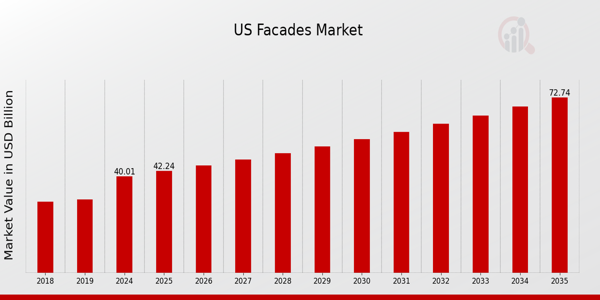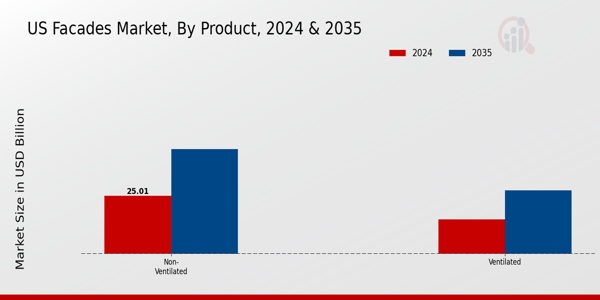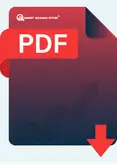US Facades Market Overview
As per MRFR analysis, the US Facades Market Size was estimated at 37.89 (USD Billion) in 2023. The US Facades Market Industry is expected to grow from 40.01(USD Billion) in 2024 to 72.74 (USD Billion) by 2035. The US Facades Market CAGR (growth rate) is expected to be around 5.584% during the forecast period (2025 - 2035).
Key US Facades Market Trends Highlighted
In the US Facades Market, several key market drivers have significantly shaped the landscape. The growing emphasis on energy efficiency is one of the foremost drivers, with building codes and regulations increasingly mandating the use of materials that enhance thermal performance. Furthermore, the demand for sustainable building practices has fostered a shift toward eco-friendly materials and designs, which are becoming pivotal in both residential and commercial projects.
Opportunities to be explored include the integration of smart technology into facade systems, allowing for real-time monitoring and adjustments that can improve building performance. The rise of prefabricated and modular constructions also presents a chance for the market to innovate and reduce construction time, leading to higher efficiency and cost savings.
Recent trends indicate a notable shift towards the use of natural materials, as architects and builders focus on creating buildings that harmonize with their surroundings. Additionally, there is a growing interest in adaptive reuse projects where older structures are modernized with contemporary facade designs, promoting sustainability by recycling existing materials.
The US continues to see increased investments in green building initiatives, spurred by both government incentives and consumer preference for sustainable living. These trends reflect a marked transition in the US Facades Market towards more environmentally conscious, efficient, and innovative solutions, catering to new construction methods and the dynamic needs of the urban environment.

Source: Primary Research, Secondary Research, MRFR Database and Analyst Review
US Facades Market Drivers
Growing Emphasis on Energy Efficiency
The US Facades Market Industry is experiencing significant growth driven by the rising need for energy-efficient building solutions. Recent studies indicate that buildings are responsible for approximately 40% of the total energy consumption in the United States, according to the United States Environmental Protection Agency. This has led to increased regulations and standards aimed at enhancing energy efficiency in construction.
Notably, organizations such as the American Institute of Architects (AIA) have been advocating for sustainable design practices, encouraging the adoption of facades that enhance thermal performance and reduce energy costs. As a result, energy-efficient facades are gaining traction, with a projected increase in demand driven by consumers and regulatory requirements alike, ultimately boosting the growth of the US Facades Market Industry.
Additionally, energy-efficient facades can lead to a decrease in energy bills by up to 30%, urging builders and developers to invest in such solutions to meet both regulatory mandates and consumer preferences.
Rising Construction Activities in Urban Areas
The US Facades Market Industry is also being propelled forward by the surge in construction activities, particularly in urban areas. The US Census Bureau reported that construction spending in the United States reached record levels, surpassing $1.5 trillion in recent years. This growth is primarily driven by urbanization, with more people moving to cities and increasing the demand for residential and commercial spaces.
The surge in construction leads to a corresponding demand for facades, which are essential components of modern buildings. Additionally, major developers and construction companies are investing heavily in new urban developments, resulting in a growing market for advanced facade solutions that combine aesthetics with practicality.
Technological Advancements in Facade Materials
Advancements in materials technology are playing a pivotal role in shaping the US Facades Market Industry. Innovative materials such as glass, aluminum, and composite panels are becoming more readily available and are being utilized to create visually appealing and functional building facades. According to the National Association of Home Builders, advancements in materials science have led to the creation of hybrid facades that enhance structural integrity while also improving energy efficiency and aesthetics.
Such developments encourage architects and builders to explore creative designs and sustainable practices, ultimately driving the growth of the market. This enables the creation of sustainable and resilient buildings that not only meet regulatory standards but also cater to modern aesthetic demands.
US Facades Market Segment Insights
Facades Market Product Insights
The US Facades Market is characterized by a diverse range of products that cater to various architectural and engineering needs. Within this market, the Product segment encompasses critical components such as Ventilated and Non-ventilated systems, each serving distinct purposes in building design and energy efficiency.
Ventilated systems are particularly significant due to their ability to enhance thermal performance and indoor air quality, addressing an increasing demand for sustainable building practices. These systems allow for air circulation behind the facade, thereby reducing heat buildup and moisture accumulation, which is crucial in the US's varied climate zones.
With energy efficiency becoming a pivotal aspect of construction, Ventilated facades promote the use of renewable energy sources and contribute positively to energy savings, aligning with government initiatives aimed at reducing carbon footprints.
On the other hand, Non-ventilated facades, while offering different benefits, focus more on aesthetic appeal and simplicity in installation. These systems provide an essential barrier to weather elements and are often used in urban developments where architectural uniformity and design are critical.
The ability of Non-ventilated facades to support various material finishes makes them flexible options for architects, contributing to a significant share of the overall facade market. The growing trend towards urbanization in the US has sparked interest in both segments, as builders and developers seek innovative solutions that balance functionality and design.
As the construction industry continues to embrace modern technologies and techniques, advancements in facade engineering are expected, leading to new materials and methods that can further drive market growth and drive considerations for durability and maintenance. Overall, the segmentation of the US Facades Market reflects evolving construction trends and consumer preferences, highlighting the importance of both Ventilated and Non-ventilated facades in shaping the future of building design in the United States.

Source: Primary Research, Secondary Research, MRFR Database and Analyst Review
Facades Market Material Insights
The Material segment of the US Facades Market encompasses various components critical to building aesthetics and performance, primarily including Glass, Wool, Aluminum, and Others. Glass continues to gain traction due to its transparency and energy-efficient properties, making it a preferred choice for modern architectural designs.
Wool, known for its insulation capabilities, is increasingly incorporated to enhance energy efficiency in structures, aligning with the US government's emphasis on sustainable construction practices. Aluminum is favored for its durability, lightweight nature, and versatility, often seen in high-rise buildings and commercial projects.
Other materials in the market serve niche applications, providing innovative solutions for unique building requirements. The diverse array of materials not only caters to the aesthetic desires of architects and builders but also meets stringent energy codes and performance standards mandated in the US construction industry.
Fostering innovations in material technology, coupled with government initiatives supporting green building practices, presents significant growth opportunities in the US Facades Market.
Facades Market End-User Insights
The US Facades Market is characterized by a robust segmentation based on End-User applications, which include Residential, Commercial, and Industrial sectors. The Residential sector remains a key driver in this market, primarily due to the rising demand for innovative housing designs and eco-friendly materials that not only enhance aesthetics but also improve energy efficiency.
The Commercial segment plays a significant role as well, with the increasing trend of urbanization and the construction of smart buildings leading to an uptick in facade installations that cater to both luxury and utility.
Meanwhile, the Industrial segment is crucial for the market's stability, driven by the need for durable and functional facades that can withstand harsh working conditions while providing insulation and energy efficiency.
Together, these sectors significantly contribute to the overall growth dynamics within the US Facades Market by addressing a broad range of consumer needs and preferences, thereby reflecting market growth opportunities in design, sustainability, and technology adaptation.
US Facades Market Key Players and Competitive Insights
The US Facades Market is characterized by a diverse range of players who compete across various segments including residential, commercial, and industrial applications. This market has been witnessing significant growth due to increasing construction activities, urbanization, and an emphasis on energy-efficient building designs. Competitive insights reveal that companies in this space are increasingly investing in innovative solutions and advanced technologies to enhance their product offerings.
The emphasis on sustainability has also driven numerous players to invest in eco-friendly materials and designs. Additionally, partnerships, regional expansion, and strategic mergers and acquisitions are common strategies employed by these competitors to strengthen their market position and widen their customer base.
These dynamics create a competitive landscape where agility and responsiveness to market trends play critical roles in determining the success of organizations within the sector.
Kawneer
Kawneer stands out in the US Facades Market due to its strong reputation for quality and innovation in architectural aluminum systems. The company has established itself as a leader by consistently delivering durable, high-performance products that meet the evolving needs of the construction industry. Kawneer's strengths lie in its extensive product portfolio that includes curtain wall systems, storefronts, windows, and entrances, all designed to offer aesthetic appeal while maintaining energy efficiency.
The company has a robust market presence, complemented by its established relationships with contractors, architects, and builders. These relationships are enhanced through Kawneer's commitment to customer service, technical support, and training, ensuring high satisfaction levels among its clients.
The company’s focus on research and development further empowers it to stay ahead of market trends and deliver products that address both functionality and sustainability.
Kawneer Company
Recognized for its role in the US Facades Market, Kawneer offers an impressive array of products and services tailored for the construction sector. The company specializes in architectural aluminum products that enhance the aesthetic and functional aspects of buildings. Its key products, which include various glazing systems, curtain walls, storefronts, and framing systems, are designed with an emphasis on energy efficiency, durability, and design flexibility.
Kawneer's strength lies not only in its innovative product lines but also in its extensive distribution network, facilitated by a well-established manufacturing and supply chain strategy within the US. The company has successfully navigated strategic mergers and acquisitions to enhance its market position and broaden its capabilities, thereby solidifying its presence in the competitive landscape of the US Facades Market.
This proactive approach enables Kawneer to respond effectively to market demands while maintaining its commitment to sustainability and customer satisfaction.
Key Companies in the US Facades Market Include:
- Mitsubishi Heavy Industries
- Graham Architectural Products
US Facades Market Industry Developments
Recent developments in the US Facades Market reflect a dynamic environment characterized by innovation and significant collaborations among key players. Companies such as Kawneer, Skanska, and Saint-Gobain are pushing boundaries through sustainable practices and advanced materials to enhance building efficiencies.
The market has witnessed strong growth, with a notable increase in demand for energy-efficient facade solutions, necessitated by stringent regulatory changes aimed at reducing carbon footprints in construction. In September 2023, Mitsubishi Heavy Industries announced a strategic partnership with C.R. Laurence to enhance their offerings in the facade systems segment, focusing on integrating smart technology within their products.
Additionally, in August 2023, Alumeco and Plexus collaborated to develop lightweight composite facades that cater to the evolving aesthetics and functionality requirements in modern architecture. Past activities, such as the merger of Graham Architectural Products with MetlSpan in May 2022, have intensified competition and expanded capabilities within the market, ultimately benefiting end-users through innovative products.
Overall, these developments indicate a robust trajectory for the US Facades Market, driven by technological advancements and strategic alliances among leading companies.
US Facades Market Segmentation Insights
Facades Market Product Outlook
Facades Market Material Outlook
Facades Market End-User Outlook
| Report Attribute/Metric Source: |
Details |
| MARKET SIZE 2018 |
37.89(USD Billion) |
| MARKET SIZE 2024 |
40.01(USD Billion) |
| MARKET SIZE 2035 |
72.74(USD Billion) |
| COMPOUND ANNUAL GROWTH RATE (CAGR) |
5.584% (2025 - 2035) |
| REPORT COVERAGE |
Revenue Forecast, Competitive Landscape, Growth Factors, and Trends |
| BASE YEAR |
2024 |
| MARKET FORECAST PERIOD |
2025 - 2035 |
| HISTORICAL DATA |
2019 - 2024 |
| MARKET FORECAST UNITS |
USD Billion |
| KEY COMPANIES PROFILED |
Kawneer, Kawneer Company, Curtain Wall Systems, Skanska, Wausau Window and Wall Systems, Mitsubishi Heavy Industries, Alumeco, Plexus, C.R. Laurence, SaintGobain, Bostik, Technoform, Graham Architectural Products, MetlSpan, Ametek |
| SEGMENTS COVERED |
Product, Material, End-User |
| KEY MARKET OPPORTUNITIES |
Sustainable building material demand, Smart facades integration, Retrofit and renovation projects, Green building certifications, Increased urbanization and infrastructure development |
| KEY MARKET DYNAMICS |
sustainable building practices, energy efficiency regulations, architectural innovation trends, urbanization and infrastructure development, competitive pricing strategies |
| COUNTRIES COVERED |
US |
Frequently Asked Questions (FAQ) :
The US Facades Market is expected to be valued at 40.01 USD Billion in 2024.
By 2035, the US Facades Market is expected to reach a total value of 72.74 USD Billion.
The compound annual growth rate for the US Facades Market from 2025 to 2035 is anticipated to be 5.584 percent.
In 2024, the Non-ventilated segment is projected to lead with a market size of 25.01 USD Billion.
The Ventilated segment of the US Facades Market is expected to be valued at 27.5 USD Billion by 2035.
Key players in the US Facades Market include Kawneer, Skanska, Mitsubishi Heavy Industries, and Saint-Gobain, among others.
The Non-ventilated segment is expected to be valued at 45.24 USD Billion by 2035.
Key growth drivers for the US Facades Market include increased construction activities and a focus on energy-efficient building solutions.
Both Ventilated and Non-ventilated segments are expected to experience growth, with the Ventilated segment reaching 27.5 USD Billion in 2035.
The market size is expected to grow significantly from 40.01 USD Billion in 2024 to 72.74 USD Billion in 2035.
















